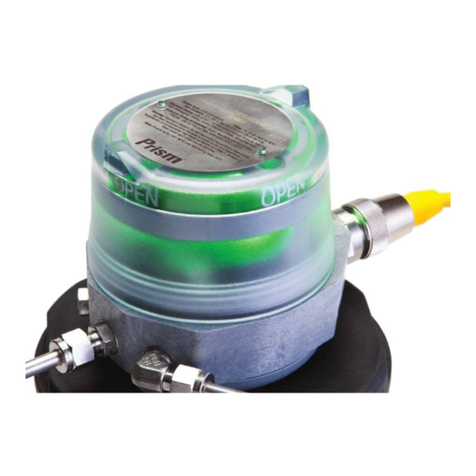
StoneL publication 105410revD
7 AN 70 en Axiom AN | 7
2 Assembly and mounting
2.1 Instructions
PLUG FOR DA
PLUG FOR SR
C
L
O
S
E
D
O
P
E
N
C
L
O
S
E
D
O
P
E
N
J
Detailed view of L
Visual indicator cutout
Steps
Refer to Axiom AN assembly gure on page 8 when performing
mounting and assembly procedures. Axiom unit and mounting kit are
supplied separately. From Axiom shipping container, ensure items A,
D, F and G are present. From the mounting kit, ensure items E, H, I, J, K,
and K are present.
1. Determine if the actuator the Axiom is to be mounted on is
double-acting (DA) or spring return (SR). Ensure the DA/SR plug
(Item J) is in the corresponding port in the air manifold plate. (See
detailed view of L below). If the DA/SR plug is in the incorrect
position, gently remove p with a pair of pliers and insert into the
proper orice.
2. Locate the air manifold plate (ItemL) and place on the actuator.
Using an M4 allen wrench, fasten with the four air manifold
mounting screws (ItemI). Torque screws to 25 to 30 in.lbs (2.8to
3.4Nm).
3. Place visual indicator drive block (ItemH) into slot in the actuator
shaft. Place visual indicator drum coupler (ItemG) onto the visual
indicator drive block. Next, place the visual indicator drum (ItemF)
onto the visual indicator drum coupler. Align the holes in all three
items with the threaded hole in the actuator shaft and fasten
down with the visual indicator drum retaining screw (ItemE).
Leave screw loose in order to facilitate indexing of the visual
indicator.
4. With the actuator in the closed position, center the visual indicator
drum until the CLOSED quadrants are centered between the visual
indicator cutouts on the air manifold plate. (See detailed view of
Kbelow). With an M4 allen wrench, tighten down with the visual
indicator drum retaining screw. Torque screws to 15 to 20 in.lbs
(1.7 to 2.3Nm).
5. Place the trigger (Item D) into the visual indicator drum, aligning
the locking tabs to the corresponding notches in the visual
indicator drum. Press down on trigger until the locking tabs snap
into place.
6. Verify air manifold plate orice o-rings (ItemJ) are in place.
7. Set the Axiom body (ItemA) in place. With an M5 allen wrench,
torque the Axiom body screws (ItemC) to 8 to 10 ft. lbs (10.8 to
13.5Nm).
8. After all wiring and sensor setting procedures have been
completed, install Axiom cover and tighten.
Special notes:
• Mounting of the Axiom requires a StoneL mounting kit specic to
the actuator the Axiom is to be mounted to.
• It is recommended that thread lubricant or anti-seize be used on
the Axiom body screws (Item C) prior to assembly.
• In high cycle or high vibration applications, blue Loctite® may be
used on the air manifold mounting screws (Item I) and the visual
indicator drum retaining screw (Item E).
• It is highly recommended that exhaust ports E2 and E3 be tted
with low restriction muers or breather vent caps to prevent
ingestion of water and debris into the pneumatic valve.




























